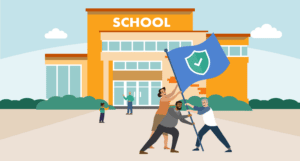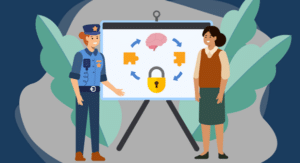Schools make a perfect emergency and disaster shelter for communities. There are many reasons for this: schools are in nearly every community, they are constructed to withstand strong winds, and they have large gathering spaces, like cafeterias and auditoriums, that can house hundreds—if not thousands—of evacuees.
Operating a shelter and ensuring everyone stays safe can be challenging. The shelter needs to be welcoming to the entire community, but it’s also the staff’s responsibility to make sure dangerous individuals are supervised and/or kept separated from others (like keeping registered sex offenders away from minors).
Mental health concerns, like depression and anxiety, can increase in times of disaster, especially considering that many evacuees are facing hardships like losing loved ones or their belongings to the disaster. Gang activity, drug or alcohol use, and theft are also common safety incidents that shelters must address quickly before the situation escalates.
Below are some ways schools can use visitor, volunteer, and emergency management systems to tackle these, and other, issues when operating as a school emergency disaster and hurricane shelter.
Verify Identity and Streamline Registration
Every entrant, including media, must sign into the shelter upon arrival and sign out before they leave. This allows you to have an accurate headcount of who is in the facility, which is critical to maintain fire safety and account for people if you need to evacuate. You should collect the date and time each person checked in, as well as their full name, contact information, and any medical conditions or special needs.
Ask certain health questions, like if the person is injured or has lost a loved one in the disaster, to determine if the evacuee should see your mental health support team. Make sure to keep all registrant information secure and protected. You also should ask COVID-19 health screening questions so you can place those with exposure risk in a separated area.
It’s important to note that it is the shelter’s responsibility to keep shelter residents safe, including keeping sex offenders separated from children.
A visitor management system can streamline the registration process, create accurate reporting, and perhaps most importantly, screen every entrant against the sex offender databases in all 50 states. Verifying this information will help you follow applicable, local laws and place those individuals in areas away from children.
Screen, Approve, and Track Volunteers
It’s crucial to know precisely who is volunteering in your shelter, especially since they may be responsible for registering evacuees and providing care to children and disabled persons. Volunteers through the American Red Cross, the most well-known disaster partner, are screened and complete a background check. However, people in your community, like your parents/guardians, may want to volunteer through your school. Many times, they ask immediately before, during, or after the disaster, leaving the school little time to complete a manual screening process.
An automated school volunteer management system can streamline the application process, track hours, and quickly confirm each volunteer is safe to work with evacuees and keep their personal information secure. The system should integrate with your visitor management system and provide a customizable online volunteer application, full criminal background checks, volunteer hour tracking, and robust reporting. It should even help you track virtual volunteers (those who are working ‘behind the scenes’ and not physically at the shelter.)
Address Safety Issues with a Mobile Panic Button
To help maintain a safe shelter environment, it’s important that everyone is prepared to address and resolve safety issues. Some of the most common issues include:
- Weapons
- Drinking alcohol
- Using or selling illegal drugs
- Theft or damage of personal or shelter property
- Disruptive behavior
- Gang activity
To streamline reporting of safety incidents and to request the right help immediately—from wherever the staff member or volunteer is in the facility—you should leverage a mobile panic button. Initiating the button should alert shelter management and security personnel of the incident, so they can respond accurately and promptly before the situation escalates.
Choosing the Right Safety Software
When you team with the right partner, they can bring knowledge and trusted solutions to keep your school and community safe not only against weather-related events, but all types of threats and emergencies.
Raptor provides visitor, volunteer, and emergency management software that empowers schools to approve all entrants, successfully respond to any emergency, manage volunteers, and confidently respond to COVID-19—all in one, user-friendly integrated suite.
Contact us today to learn more and schedule a personalized demo.





